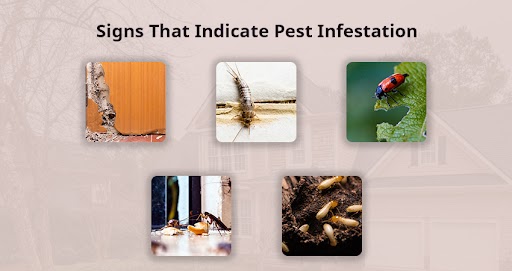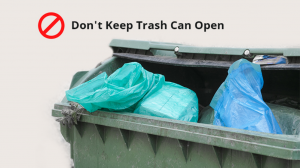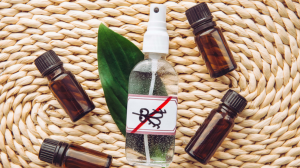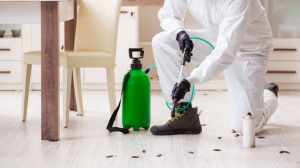8 Signs That Indicate Indoor and Outdoor Pest Infestation
Published Date: July 25, 2022

Homeowners, buyers, and even renters often become overwhelmed by neglected pest invasions in their homes. That’s why knowing what sign is most likely to indicate a pest infestation is crucial. If you ignore these signs, you’ll have to enlist a pest exterminator later.
Signs Of Pest Infestation
Pest control professionals are effective in eliminating infestations from your home. Before calling the experts, however, you need to know how to detect evidence of the presence of these pests.
- Pest Droppings and Sounds: Rat and mice droppings are black, shiny, and with pointy ends. Rats and mice scratch, gnaw and squeak. Bats also squeak but flutter as well, particularly at night. They are nocturnal animals, and you may often mistake them for rats and mice.
However, they are found in dark crevices higher up your houses, such as your attic.
- Damaged Furniture: Termites are some of the most destructive pests you can find. They dine on wood which, if left unchecked, can quickly compromise the structure of your building and furniture.
- Some Insects Moving or Flying in the House: Cockroaches and flies are the most common pests you will encounter. The presence of unkempt alleys, basements, and the accumulation of garbage will always attract cockroaches and flies since they are havens for food and breeding.
- Soil Heaps: Ants will build hills around structures along your fence and pavement cracks. Coarse piles of dirt with a hole at the tops indicate the presence of ants. Ants exist in colonies, so you’ll spot numerous tracks to and from areas where food is available.
- Cobwebs: Spiders solely feed on insects, meaning that the amount of spiders is proportionate to the food supply in your house. If you don’t see other bugs in your home, it likely means that spiders control their population.
- Predator Insects in the Lawn: Although ladybugs are beautiful to come across on your lawn, a big influx may be a bearer of bad news. The favorite delicacy for ladybugs is aphids, which are a severe enemy to your property and garden. Ladybugs also feed on mites, white flies, and small-scale insects.
- Musty Odor: Bed bugs give off a musty odor. The female lays hundreds of eggs that mature in a month. They live in your beddings, luggage, and clothes. They might come from second-hand items you bring into the house.
- Holes and Dead Plants in the Lawn: Moles feed on insects in the grass and love to dig holes in your lawn. They are easy to spot, as you should look out for raised ridges across your property accompanied by small hills of dirt. The dirt is generated as the mole tunnels through your lawn, looking for food.
Now that you know some indicators, hopefully, you can tell what sign is most likely to indicate a pest infestation.
What Are the Best Ways To Prevent Pest Infestation
1. Do It Yourself (DIY)

DIY solutions for preventing pest infestation include simple acts like taking out the trash. Once you remove the garbage inside your house, you minimize the chances of pests coming into your home. For trash containers outside your house, ensure that their lids are closed and in good repair to reduce access to pests.
There are many ways for pests to get into your home. Be proactive against problems by conducting regular interior and exterior house inspections. Then, seal up all cracks and holes you may find. In addition, you should pay close attention to broken windows and cracks on your foundation, roof, and utility lines.
2. Home Remedies

Try a homemade recipe to control pests in your home. For example, spray a simple vegetable oil and water solution to kill aphids, white flies, and mites. The oil coats their bodies, blocking the pores they use to breathe.
Water-based solutions ward off the typical garden and household pests. For instance, you can use Eucalyptus as an effective solution to manage bees and wasps, while most salts will take care of ants, caterpillars, slugs, and worms.
The advantage of using home remedies is that they have a minimal environmental impact . In addition, most of the plant remedies you will use have other cleansing attributes, allowing you to hit two birds with one stone. The disadvantage is that they will often take time and aren’t as potent as chemical solutions to pest control.
3. Chemical Solutions

Chemical pest control methods include the use of pesticides to quickly eliminate insects. You should consider this method if an infestation spirals out of control.
Preventive chemical solutions include the use of repellents. Repellants allow you to ward away pests from your house. However, these repellants don’t necessarily kill the pests and thus might not be a foolproof solution in cases of high infestation.
Pesticides kill insects and pests indiscriminately. You should choose this option as a last result since it is so destructive. Prepare to carry out an entire house cleaning after applying pesticides to remove any foul smells and dead insects.
You should be cautious about using chemical solutions as many of these are dangerous to your health. While some of these adverse health effects are only temporary, long-term exposure has serious side effects. Additionally, the correct usage and disposal of pesticides and pesticide containers will significantly reduce their impact on the environment.
4. Professional Pest Control

Although pest infestation can eradicate budding infestations, failure of the previous three methods warrants hiring the services of a professional. First, evaluate the type of pest you have, how widespread they are, and their place of origin. Then, you can schedule a consultation with a professional exterminator to finally end the problem.
Final Words
They say that prevention beats a cure. While there are concrete solutions to an ongoing pest infestation, you may want to take proactive measures to prevent them in the first place. Part of this is knowing what sign is most likely to indicate a pest infestation.
Keep openings and thresholds closed at all times. Do a weekly cleaning around the kitchen and yard to reduce the likelihood of pests taking residence on your property.
By exercising caution and being thorough with maintaining cleanliness, you’ll prevent an infestation from occurring in the first place. However, if the worse comes to the worst, hiring a professional exterminator is always an effective final option.




